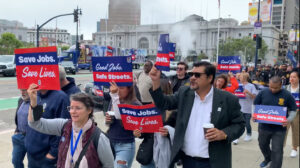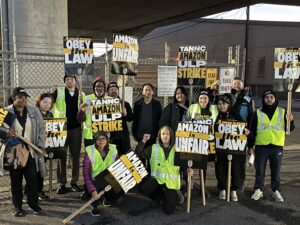COVID-19 in the workplace: How can you and your union respond to ‘Abnormally Dangerous’ Conditions
July 1, 2020So much is still unknown about COVID-19 (such as, how exactly it spreads, why the symptoms can range from mild to extreme, and whether you can develop immunity.) It may be impossible to say with absolute legal certainty what is so “unsafe” as to justify a refusal to work. However, the stakes are quite high: refusal to follow a direct order to ‘get to work’ or ‘keep working’ is insubordination and the penalty for insubordination is often termination.
A review of the law
What’s the law here? Section 502 of the federal Labor Management Relations Act states that, “the quitting of labor by an employee or employees in good faith because of abnormally dangerous conditions for work at the place of employment” cannot be deemed an unlawful strike under law or under the union contract’s “no strike” provision. But how far does this go? Applying this Section, the National Labor Relations Board has held that:
(1) the employees must believe in good faith that their working conditions were abnormally dangerous;
(2) their belief was a contributing cause of the work stoppage; and
(3) the employees’ belief that their working conditions were abnormally dangerous can’t be based on suspicion, rumors or generalized fears; it must be “supported by ascertainable, objective evidence;” and,
(4) “the perceived danger posed an immediate threat of harm to employee health or safety.” (TNS, Inc., 329 NLRB No. 61 (1999).
The federal and California Occupational Safety and Health Administrations (OSHA and Cal OSHA) apply similar “ascertainable, objective evidence” standards as to whether an employee is protected from discipline if they refuse to work because of health or safety concerns.
And under your union contract, “just cause” for discipline or discharge generally assumes that for purposes of a direct order that you disagree with, you must “obey and grieve.”
The political challenge
Consider this though: the agencies that now get to decide whether employees’ concerns about worker safety are “supported by ascertainable, objective evidence [of] an immediate threat of harm” are the NLRB and federal OSHA, both appointed by Donald J. Trump. In other words, because the law is only as reliable as the people obligated to enforce it, anyone considering the refusal of an order to “get back to work” needs to keep in mind the risks of relying on the people now running the federal government to do the right thing.
So where does that leave an employee in this pandemic justifiably concerned about their safety? The law in certain parts of California allows employees particularly vulnerable to COVID to be excused from work.
What about the rest of us who feel that the conditions under which we are being asked to work in circumstances that “pose an immediate threat of harm to employee health and safety?”
In almost every situation possible where you consider a direct employer order to “pose an immediate threat of harm” before considering disobeying that order, ask for or get ahold of your union steward and make sure your steward calls your Business Agent. If there is no time to do that and you disobey the order on grounds of health and safety, you take a risk of losing your job.
Difficult choices for difficult times.





